Carl E. Olson's Blog, page 295
August 11, 2011
20% off select books, films and music | Celebrating the Feast of the Assumption of the Blessed Virgin Mary
[image error]
Celebrating the Feast of the Assumption of the Blessed Virgin Mary
Offer ends Tuesday, August 16th, 2011 at 12:00 midnight EST. These prices are available online only through Ignatius.com
August 15th marks the Feast of the Assumption of the Blessed Virgin Mary into Heaven. Ignatius Press is honoring this feast day by offering 20% off on a large selection of books, DVDs and music that we hope will enrich your lives and deepen your Catholic faith. Our Blessed Mother said "yes" to God and became the sinless Mother of Our Savior, for which God honored her by assuming her body and soul into Heaven. Let us imitate her in our own lives by renewing daily our love of God and neighbor.
Sale items are listed below:
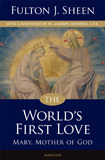 The World's First Love (2nd edition)
The World's First Love (2nd edition)
Mary, Mother of God
Archbishop Fulton J. Sheen
With his characteristic eloquence and brilliance, Fulton J. Sheen presents a moving portrayal of the Blessed Virgin Mary that combines deep spirituality with history, philosophy and theology. All the major aspects and events of Mary's life are lovingly portrayed in this word portrait that is a never failing source of information, consolation and inspiration.
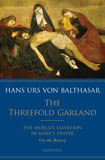 The Threefold Garland
The Threefold Garland
The World's Salvation in Mary's Prayer
Hans Urs von Balthasar
The renowned Swiss theologian offers in this little book very beautiful and practical reflections for praying and living the 15 mysteries of the Rosary. He makes the profound truths and events of our salvation take on a freshness and splendor by allowing the reader to enter his own contemplation of the mysteries.
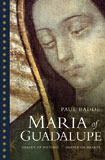 Maria of Guadalupe
Maria of Guadalupe
Shaper of History, Shaper of Hearts
Paul Badde
Mexico, December 9, 1531. Ten years after the Spaniards conquered this land, on a hill on the outskirts of the capital, something inconceivable happens to Juan Diego, a native of the area. At dawn a heavenly figure comes to meet him, revealing herself as "Mary, mother of all men". To confirm the first vision, the Lady not only entrusts him with several messages. But, also, in the final vision, leaves her portrait mysteriously present on his tilma. In this heartfelt report, Paul Badde tells the fantastic story of the apparition that changed the history of the world.
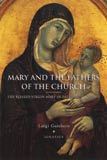 Mary and the Fathers of the Church
Mary and the Fathers of the Church
The Blessed Virgin Mary in Patristic Thought
Luigi Gambero
Father Luigi Gambero, internationally-known expert on early Christianity, presents a comprehensive survey of the development of Marian doctrine and devotion during the first eight centuries. Focusing on the lives and works of over thirty of the most famous Church Fathers and early Christian writers, Fr. Gambero has produced a clear and readable summary of the richness of the patristic age's theological and devotional approach to the Mother of God.
Mary in the Redemption
Adrienne von Speyr
In this profound work on Our Lady, Von Speyr explores Mary's participation with Christ in our redemption, and the unique relationship that each of us should have with our spiritual mother.
The Rosary: Chain of Hope
Fr. Benedict J. Groeschel
Responding to the Pope's Apostolic Letter on the Rosary, his five new "Luminous Mysteries", and declaration of 2003 as "The Year of the Rosary", Fr. Groeschel presents this book of meditations on all 20 mysteries of the rosary.
Fr. Peyton's Rosary Book
Fr. Patrick Peyton
The most complete prayer book of meditations on the mysteries of the Rosary today.
Mary: God's Yes to Man
Encyclical Letter: Redemptoris Mater
The Church's supreme magisterium and representative of the Church's most penetrating theological reflection combine to provide for all the faithful a rich and concise compendium of the Mother of the Redeemer.
Mary in the Middle Ages
Luigi Gambero
In his book Mary and the Fathers of the Church, Fr. Luigi Gambero presented a comprehensive survey of Marian doctrine and devotion during the first eight Christian centuries. Mary in the Middle Ages continues this journey up to the end of the fifteenth century, surveying the growth of Marian doctrine and devotion during one of the most important eras of Christian history: the Middle Ages.
Splendors of the Magnificat
A stunning art book with audio CD to enter into the spirit of Mary's Magnificat guided by master artists and composers.
Mary
The Church at the Source
Joseph Cardinal Ratzinger
At once profound and yet readily accessible, Mary: The Church at the Source offers a theologically balanced and biblically grounded presentation of traditional and contemporary thought on Marian doctrine and spirituality.
Handmaid of the Lord
Adrienne von Speyr
Von Speyr's masterpiece on the life, attitude, and prayer of the Mother of God.
Maiden and Mother
Devotions to the Blessed Virgin Mary throughout the Year
M. M. Miles
This unique Marian devotional includes hymns, prayers, songs, ballads, litanies, and other texts drawn from all centuries, bringing together a precious collection of texts from the most ancient to modern.
Daughter Zion
Meditations on the Church's Marian Belief
Joseph Cardinal Ratzinger
Daughter Zion explores the biblical witness to the Church's Marian dogmas―Mary's role as Mother of God, her virginity, the Immaculate Conception, and her Assumption into heaven.
Mary for Today
Hans Urs von Balthasar
The acclaimed theologian von Balthasar gathers from the Sacred Scriptures and the richest tradition of the Church the elements of a portrait which shows Mary's place and her relevance for today.
The Seven Joys of Mary
Romanus Cessario, O.P.
A beautiful book of meditations illustrated with more than 70 full-color reproductions of the masterpiece The Seven Joys of the Virgin by Hans Memling.
DVDs
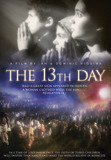 The 13th Day
The 13th Day
In a world torn apart by persecution, war and oppression, 3 children in Fatima, Portugal were chosen by God to offer an urgent message of hope to the world. Based on the memoirs of the oldest seer, Lucia Santos, and many thousands of independent eye-witness accounts, The 13th Day dramatizes the true story of three young shepherds who experienced six apparitions of Our Lady between May and October 1917, which culminated in the final prophesied Miracle of the Sun on October 13th.
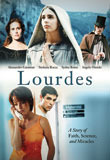 Lourdes
Lourdes
A Story of Faith, Science and Miracles
Bernard Guillaumet, a non-Christian French journalist, is assigned the job of doing a story on Lourdes in the late 1990s. Just before he leaves for Lourdes, Bernard learns that his wife is pregnant. However, he is not told that this pregnancy could put her life at risk-and that doctors are suggesting an abortion. While researching for his report on Lourdes, Bernard comes across the pages of an old family manuscript. This intriguing film uses the pages of the manuscript to trace the stories of three lives- Bernadette, Henry and Bernard, three characters whose lives intertwine as they pursue parallel journeys according to the designs of Providence.
Finding Fatima
Produced by the award-winning filmmakers of the highly acclaimed feature film The 13th Day, this is a powerful and in-depth documentary that combines archival footage, dramatic reenactments, original interviews with Fatima experts and stunning visuals to tell the whole story of the apparitions of Our Lady of Fatima.
Bernadette
150th Anniversary Edition
From Jean Delannoy, one of France's foremost filmmakers, comes this top quality feature film production of the story of St. Bernadette and the apparitions of Our Lady of Lourdes.
Footprints of God: Mary
The Mother of God
This second film in the the Footprints of God series follows Mary on her extraordinary journey on location in Turkey, Israel and Greece with popular Catholic author and speaker Stephen Ray as guide.
What Every Catholic Needs to Know About Mary
After viewing this DVD, you'll be empowered with the truth about such important Marian topics as her Divine Maternity, Perpetual Virginity, Immaculate Conception, and Bodily Assumption into Heaven.
MUSIC
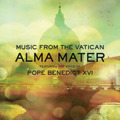 Alma Mater
Alma Mater
Songs & Prayers to Mary
This unique and amazing new recording features Pope Benedict singing or reciting hymns and prayers to Our Lady accompanied by The Vatican Choir. His Holiness uses several languages in this recording including Latin, Italian, French, all recorded at St. Peter's Basilica or during his Papal trips abroad.
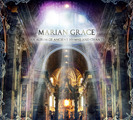 Marian Grace
Marian Grace
Ancient Hymns and Chants
A gorgeous new recording by Marian Grace, a very talented young Nashville-based musical group whose lofty goal is to uncover the Church's richest musical treasures and to transform culture through the marriage of beauty and truth.
Catholic Marian Classics
Richard Proulx and his Cathedral Singers once again bring their incredible talents to this sequel to Catholic Latin Classics, presenting lovely sacred music and moving renditions of 21 classic Marian hymns that are a wonderful tribute to Our Lady
Through the Eyes of His Mother
Rosary, Divine Mercy, Hymns
The complete Rosary and Divine Mercy meditation set, with Irish tenor Mark Forrest, wife Muriel and Fr. Francis Peffley providing beautiful meditations and vocal prayer for all 20 Rosary mysteries, Divine Mercy Chaplet, and the Litany of the Saints.
The Rosary and the Chaplet of Divine Mercy
Recorded at the National Shrine of The Divine Mercy, the prayers are led by Shrine Rector, Fr. Dan Papineau, M.I.C., with Vinny Flynn and his Still Waters family ministry. The gentleness of the voices, together with a soft instrumental music in the background, creates a wonderful atmosphere of quiet meditative prayer.
Liberal Studies Program
Under the leadership of Ignatius Press founder and editor, Father Joseph Fessio, Chancellor, the Liberal Studies Program ("LSP") provides unrivaled educational opportunities for homeschoolers, high school students, and college students, to earn college credit while acquiring the foundations for a Catholic liberal education and lifelong learning. Click HERE to learn more!
"Finding Fatima" is "captivating"; an "excellent film for family movie night"
Leticia Velasquez of Catholic Online reviews the DVD, "Finding Fatima", which was produced by the award-winning filmmakers of the film "The 13th Day":
The Higgins brothers are the same British filmmakers who produced the Fatima drama "The 13th Day," "Finding Fatima" is a docu-drama about the apparitions which capitalizes on the interest their earlier film evoked by answering many of the questions left unanswered by the earlier film. They make a perfect companion set. They both have the unique 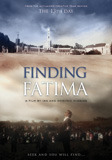 chiaroscuro tint, and enough drama to keep the casual viewer interested.
chiaroscuro tint, and enough drama to keep the casual viewer interested.
In several interviews with Fatima experts like Fr Andrew Apostoli, relatives of eyewitnesses and the Fatima seers themselves, and dramatic recreations of eyewitness accounts illustrated with film clips, the actual events of the apparitions are described in a captivating way while providing the details which educate the viewer about that apparitions.
...
One little explored aspect of Fatima is the connection Fatima has with Muslims. Perhaps one of the most relevant aspects of Fatima for our times; is the fact that many Muslims are drawn to Fatima. This was all in God's plan, according to Archbishop Fulton Sheen who said,
Since nothing ever happens out of Heaven except with a finesse of all details, I believe that the blessed Virgin chose to be known as "Our Lady of Fatima" as a pledge and a sign of hope to the Muslim people, and as an assurance that they, who show her so much respect, will one day accept her divine Son too.
In my personal experience, I once met a Muslim leader at a Marian conference who said, "I have to know more about St Fatima, I have a statue of her in my home."(He was referring to Our Lady of Fatima.) The gentleman finished the conference by breaking down in tears as he was prayed over by a priest. He seemed to be on the road to conversion. Could Fatima contain the secret to World Peace? Would adherence to the call of Fatima bring about the end of terrorism, the scourge of our times?
An excellent film for family movie night, though some of the recreation of the atomic bomb, hell and war torn Europe may be disturbing for children younger than 8 years.
Highly recommended.
Related on Insight Scoop and Ignatius Insight:
• "I thought I knew a lot about Fatima ... but I learned a ton from 'Finding Fatima'." (July 18, 2011)
• The Controversy Over the Third Secret: Objections and Responses | Fr. Andrew Apostoli, C.F.R. | Appendix D from Fatima For Today: The Urgent Marian Message of Hope
August 10, 2011
On "the practical difficulty of arousing any sort of enthusiasm for the worship of nothing in particular"
An Episcopal pastor provides some thoughtful analysis about the attraction and apparent success of American Evangelicalism, especially compared to liberal Protestantism (no, I'm not being sarcastic; it really is thoughtful):
What do Evangelicals have that we (Progressive, Mainliners) don't have—other than larger churches, larger seminaries, bigger attendance on Sunday, more serious engagement with Scripture, and enough passion for their faith to keep David Platt's Radical on the best seller list for 55 weeks running?
We can sniff and comfort ourselves with pride, if we want to do that. But I am sure that was pretty much where the crew of the Titanic lived just before the ice water began to roll in over their feet.
Don't get me wrong. This isn't a size thing. But we can only console ourselves for so long by arguing, "small is beautiful" or "we are too sophisticated to be popular." "Large" may not mean "good," but "small" is not necessarily a synonym for "virtuous" either. Sometimes, small just means "not all that interesting."
The question is also prompted by the tenor and level of engagement that Evangelicalism inspires. To get just a taste of it, read the obituary in last week's New York Times describing the life of John R. W. Stott who died on July 27.
There's another problem with dismissing Evangelicals out of hand: Many of the excuses we tell ourselves are based on a caricature that simply isn't fair or particularly accurate. Evangelicalism has its problems, but the ones it does have rarely receive attention and a lot of the criticisms laid at its doorstep are simply not true. Evangelicals are often bright, well educated, and comfortably middle class. They are not necessarily literalists or inerrantists. And contrary to the old stereotype, they do not hold the monolithic positions on social issues that some suppose.
So, it's time to ask, "What do they have?" Here's what I think explains the popularity of Evangelicalism:
Evangelicals believe something. To name a few things: They believe in God, the Trinity, the humanity and divinity of Jesus Christ, the Resurrection, and the authority of Scripture. These things define reality in a particular way for Evangelicals.
Read the entire essay, "What do Evangelicals have that we don't?", on the SMU site. The author, Rev. Dr. Frederick W. Schmidt, is an Episcopal priest and is director of Spiritual Formation and associate professor of Christian Spirituality at Southern Methodist University, Perkins School of Theology in Dallas, Texas.
The final paragraph from the excerpt above brings to mind a delightfully caustic passage from an essay, "The Dogma Is the Drama", written by the wonderful Anglican author, Dorothy Sayers (1893-1957):
Any stigma," said a witty tongue, "will do to beat a dogma"; and the flails of ridicule have been brandished with such energy of late on the threshing-floor of controversy that the seed of the Word has become well-nigh lost amid the whirling of the chaff. Christ, in His Divine innocence, said to the Woman of Samaria, "Ye worship what ye know not" — apparently being under the impression that it might be desirable, on the whole, to know what one was worshipping. He thus showed Himself sadly out of touch with the twentieth-century mind, for the cry today is: "Away with the tedious complexities of dogma — let us have the simple spirit of worship; just worship, no matter of what!" The only drawback to this demand for a generalized and undirected worship is the practical difficulty of arousing any sort of enthusiasm for the worship of nothing in particular. ...
We are constantly assured that the churches are empty because preachers insist too much upon doctrine — 'dull dogma,' as people call it. The fact is the precise opposite. It is the neglect of dogma that makes for dullness. The Christian faith is the most exciting drama that ever staggered the imagination of man — and the dogma is the drama. . . . This is the dogma we find so dull — this terrifying drama which God is the victim and the hero. If this is dull, then what, in Heaven's name, is worthy to be called exciting? The people who hanged Christ never, to do them justice, accused Him of being a bore — on the contrary; they thought Him too dynamic to be safe. It has been left for later generations to muffle up that shattering personality and surround Him with an atmosphere of tedium. We have very efficiently pared the claws of the Lion of Judah, certifying Him 'meek and mild,' and recommended Him as a fitting household pet for pale curates and pious old ladies. (from The Whimsical Christian: 18 Essays [New York, 1978]).
Compare Schmidt's essay, which is refreshingly reflective and honest, with a recent rant in The Guardian (see my August 8th post about it), also written by an Episcopalian, that was unthinking, bitter, and thoroughly condescending.
Father Maximilian Heim one of three winners of the first Joseph Ratzinger Prize
From a Catholic News Service report that I missed when it came out on June 30th:
The pope gave three European theologians the Ratzinger Prize for their excellence in theological studies: Manlio Simonetti, an 85-year-old Italian professor and expert in ancient Christian studies and patristic biblical interpretation; Father Olegario Gonzalez de Cardedal, a 76-year-old Spanish priest and professor of dogmatic and fundamental 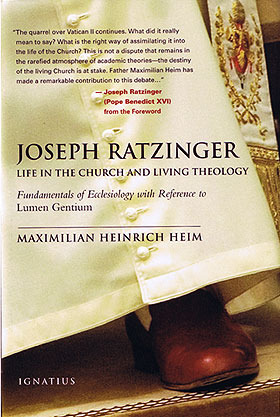 theology; and Cistercian Father Maximilian Heim, a 50-year-old German theologian and abbot of the Heiligenkreuz monastery in Austria.
theology; and Cistercian Father Maximilian Heim, a 50-year-old German theologian and abbot of the Heiligenkreuz monastery in Austria.
The pope used the occasion to talk about the significance and the challenges surrounding theology.
He noted the important contributions theology has made, but warned that theology must not only be concerned with the past as that would "leave the faith today in darkness." ...
During the ceremony, the pope greeted each of the prize recipients, handing them each a large award certificate and a small envelope.
The prizes included a check for $87,000.
The Ratzinger Prize will be awarded each year in sacred Scripture, patristics and fundamental theology.
This was the first time the prizes were awarded since the establishment last year of the Joseph Ratzinger (Benedict XVI) Vatican Foundation, which promotes theological studies on the pope's writings and to reward promising scholars.
(By the way, the money used by the Joseph Ratzinger-Benedict XVI Vatican Foundation comes from the royalties from the books written by Joseph Ratzinger.) Cistercian Father Maximilian Heim, is a 50-year-old professor of fundamental and dogmatic theology as well as Abbot of Heiligenkreuz [Holy Cross] Monastery in Bavaria. He is the author of Joseph Ratzinger—Kirchliche Existenz und existentielle Theologie (2005), translated into English by Michael J. Miller and published by Ignatius Press as Joseph Ratzinger: Life in the Church and Living Theology—Fundamentals of Ecclesiology with Reference to Lumen Gentium (2007). The book was awarded the Cardinal Innitzer Prize in Vienna, and the Johann-Kaspar Zeuss Prize in Kronach, Germany.
It is an outstanding work of theology and it can be purchased, as of this writing, for just $7.00 (originally $39.95!!), from Ignatius Press. Highly recommended!
The Introduction to the book can be read on Ignatius Insight:
"For [Christopher] Dawson is more like a movement than a man..."
That statement by Frank Sheed is just one of several quotes about the great British historian Christopher Dawson (1889-1970) in this fine article by Dr. Bradley Birzer, author of Sanctifying the World: The Augustinian Life and Mind of Christopher Dawson (Christendom Press, 2007):
Though precious few remember him now, Christopher Dawson stood at the very center of the Catholic literary and intellectual revival throughout the four decades preceding Vatican II. "For Dawson is more like a movement than a man," his publisher and friend, Frank Sheed, wrote of him in 1938. "His influence with the non-Catholic world is of a kind 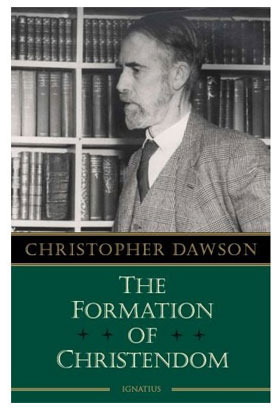 that no modern Catholic has yet had, both for the great number of fields in which it is felt and for the intellectual quality of those who feel it."
that no modern Catholic has yet had, both for the great number of fields in which it is felt and for the intellectual quality of those who feel it."
During the Great Depression of the 1930s, Catholic promoters such as Francis X. Talbot listed Dawson as a select member of America's "Permanent Gallery of Living Catholic Authors." Additionally, prominent American Catholic colleges began teaching courses on the thought of Christopher Dawson and other figures of the Catholic Literary Revival as early as the mid-1930s. Dawson's influence "can be seen on almost every major lay Catholic movement in the American Church between 1930 and 1955," historian Arnold Sparr has written.
In 1933, the American Catholic journal Commonweal stated that "the writings of Christopher Dawson demand the thoughtful attention of all educated men." Six years later, the Jesuit journal, the Month, claimed that to "commend Mr. Dawson's work is unnecessary; nothing that he writes could be unimportant." In 1949, Waldemar Gurian, a refugee from the Nazis and a professor at the University of Notre Dame, wrote that Dawson's "very ability to make brilliant understatements and to display without pride, as something self-evident, his extraordinary broad knowledge make his synthesis particularly impressive."
In 1950, the English Dominican journal, Blackfriars, claimed "that Mr. Dawson is an educator; perhaps the greatest that Heaven has sent us English Catholics since Newman."` Four years later, Frederick Wilhelmsen, himself soon to become a major player in post-war American Catholicism, concluded that Dawson was "the foremost medievalist in the English speaking world." Further, "this union of genius and Catholic scholarship has put us all in his debt."
Read the entire essay, "Christopher Dawson and the 'Twentieth-Century Catholic Literary Revival" on the Paying Attention to the Sky blog. The blog also has a number of excerpts from Dawson's writings.
Dawson's understanding of history and Christianity is captured well in these paragraphs from The Formation of Christendom:
The history of Christianity is the history of a divine intervention in history, and we cannot study it apart from the history of culture in the widest sense of the word. For the word of God was first revealed to the people of Israel and became embodied in a law and a society. Secondly, the word of God became Incarnate in a particular person at a particular moment of history, and thirdly, this process of human redemption was carried on in the life of the Church which was the new Israel--the universal community which was the bearer of divine revelation and the organ by which man participated in the new life of the Incarnate Word.
Thus Christianity has entered into the stream of human history and the process of human culture. It has become culturally creative, for it has changed human life and there is nothing in human thought and action which has not been subjected to its influence, while at the same time it has suffered from the limitations and vicissitudes that are inseparable from temporal existence.
Now there are those who reject this mingling of religion and history, or Christianity and culture, since they believe that religion is concerned with God rather than man, and with the absolute and eternal rather than the historical and the transitory. We certainly need to recognize how important this aspect of religion is and how man has a natural sense of divine transcendence. And we know from the history of religious thought that we do actually find religious men of this kind--men who seek to transcend human nature by the flight of the Alone to the Alone, in the words of the Neo-Platonist philosopher, and who find the essence of religion in the contemplation of pure being or of that which is beyond being.
But this is not Christianity. Although Christianity does not deny the religious value of contemplation or mystical experience, its essential nature is different, it is a religion of Revelation, Incarnation and Communion; a religion which unites the human and the divine and sees in history the manifestation of the divine purpose towards the human race.
Read more on Ignatius Insight.
Also see:
• The Vision and Principles of Christopher Dawson | David Knowles | Introduction to Christopher Dawson's The Dividing of Christendom
• Rediscovering Christopher Dawson | An Interview with Dr. Bradley J. Birzer
August 9, 2011
Priest cites Church's pro-life beliefs as key to leaving Episcopalianism, becoming Catholic
The Register-Guard, the largest newspaper here in Eugene, Oregon, had a front cover article in this past Sunday's edition about the new parochial vicar at the largest parish in the Eugene/Springfield area:
Two things set Father Bryce McProud apart from most newly ordained Roman Catholic priests: He once tried out for the Metropolitan Opera and placed highly enough to consider it a career option. And he's married.
The opera part is easy to understand. About 40 years ago, about the same time he was considering a calling to the ministry, he "sang quite a lot," and apparently very well. "At that point, I had to choose between opera and the church," McProud said. "I prayed about it a lot and decided to go with the church."
As for being married, McProud, a longtime minister in the Episcopal church and now parochial vicar at St. Mary Catholic Church in Eugene, received a dispensation from Pope Benedict XVI that allowed him to make the switch and, as an already married priest, to bring his wife along.
Since July 1, after a few weeks of volunteering in local parishes following his ordination on June 4, he has been a full-time member of the St. Mary clergy, celebrating Mass, officiating at funerals and hearing confessions of parishioners in the old brick church at 11th Avenue and Charnelton Street.
He and his wife, Deanna McProud, have been married "almost 41 years," he said. "We have a son, and we have two wonderful grandchildren."
The piece is quite good and does a solid job of providing background and context to Fr. McProud's rather unique situation. It also has this:
McProud's disaffection with Episcopal doctrine started in the early 1990s, "after the church's general convention voted to become pro-choice on abortion," he said. "The other major issues were not as important to me."
He had been ordained into the Episcopal priesthood in 1978 and had served in parishes in Yakima, Wash., and Albany before coming to St. Matthew's Episcopal Church in Eugene in 1985.
By 2004, he realized that he was part of the "Catholic-minded" among Episcopalians — the other two main divisions are liberal-minded and evangelical-minded, he said — and he decided to pursue a dispensation to join the Catholic clergy.
"The decision evolved over a long period," Deanna McProud said. "We talked a lot about the various churches we had been in during our lives. I always had been drawn to the Catholic Church, so it didn't seem strange to me."
Again, the background material provided by reporter Randi Bjornstad is quite helpful for readers unfamiliar with how it is that some Catholic priests in the Latin rite are married. However, the term "Roman Catholic Church" is a bit misleading (although, admittedly, used by many Catholics), as it is not a term ever used by the Catholic Church to describe herself, as Dave Armstrong and Jimmy Akin explain. Far more important, however, is this error:
However, the Roman Catholic Church doesn't recognize clergy ordained in other churches, so for McProud as well as others, the switch meant attending seminary, passing examinations and then serving for several months as a Catholic deacon before qualifying for ordination.
Not true. The Catholic Church doesn't recognize clergy ordained in Protestant denominations, but it certainly recognizes clergy ordained in the Orthodox Churches and Ancient Oriental Churches. Thus, the Vatican II Decree on Ecumenism, Unitatis Redintegratio, states:
These Churches, although separated from us, yet possess true sacraments and above all, by apostolic succession, the priesthood and the Eucharist, whereby they are linked with us in closest intimacy. Therefore some worship in common (communicatio in sacris), given suitable circumstances and the approval of Church authority, is not only possible but to be encouraged. (par. 15) ...
To remove, then, all shadow of doubt, this holy Council solemnly declares that the Churches of the East, while remembering the necessary unity of the whole Church, have the power to govern themselves according to the disciplines proper to them, since these are better suited to the character of their faithful, and more for the good of their souls. The perfect observance of this traditional principle not always indeed carried out in practice, is one of the essential prerequisites for any restoration of unity. (par. 16)
And regarding "Separated Churches and Ecclesial Communities in the West", the document states:
Though the ecclesial Communities which are separated from us lack the fullness of unity with us flowing from Baptism, and though we believe they have not retained the proper reality of the eucharistic mystery in its fullness, especially because of the absence of the sacrament of Orders, nevertheless when they commemorate His death and resurrection in the Lord's Supper, they profess that it signifies life in communion with Christ and look forward to His coming in glory. Therefore the teaching concerning the Lord's Supper, the other sacraments, worship, the ministry of the Church, must be the subject of the dialogue. (par. 22; emphasis added)
Which brings me around to a point that I bring up every few months: the majority of priests in Eastern Catholic and Eastern Orthodox Churches are married. (Bishops are chosen from those priests who are not married.) The Register-Guard article would have benefited, I think, from at least a passing reference to this fact, especially since one of the three Eastern rite Catholic churches in the state of Oregon is in the Eugene/Springfield area, Nativity of the Mother of God Ukrainian Catholic Church, which our family has attended regularly since 2000. Still, all in all, a good piece about Fr. McProud, who I hope is settling in nicely at St. Mary Catholic Church.
The Universal Call to Holiness: An Interview with Bishop Samuel Aquila

The Universal Call to Holiness | Jim Graves | Catholic World Report | August 2011
Bishop Aquila on promoting a culture of life and sanctity
Bishop Samuel Aquila of Fargo, North Dakota, 61, was born and raised in Southern California. One of three children, he was the son of a physician, and the Catholic faith was important in his home. Aquila attended Catholic schools and learned the basics of his faith from the religious sisters who taught him the Baltimore Catechism. In high school, he was taught by the Carmelite Fathers.
Aquila's Sicilian grandmother, who spoke only Italian, was an important model of piety for him growing up. She frequently stayed with his family, and Aquila recalls waking up early in the morning as a child and seeing his grandmother seated in her favorite chair, quietly praying and meditating.
He had an interest in the priesthood while he was in elementary school, but upon graduating from high school chose to pursue a career in medicine instead. He entered the University of Colorado as a pre-med student. However, in his third year of college, Aquila again began to think about the priesthood. He decided, "I really need to go test this out."
Upon graduation, he entered St. Thomas Seminary in Denver, Colorado. After six months, "It became really clear to me that the Lord was calling me to the priesthood," he said.
Aquila was ordained a priest in 1976, and served in a variety of positions in the Archdiocese of Denver before being named coadjutor bishop of Fargo, which is the eastern half of North Dakota. He was ordained a bishop in Fargo in 2001, and this year he celebrates the 10th anniversary of his arrival.
Fargo is home to 85,000 Catholics in 133 parishes. For a diocese of its size, Fargo does well for vocations, with 85 diocesan and 15 religious priests, and 17 seminarians. Bishop Aquila is known for his orthodoxy, piety and public defense of Church teaching on a variety of issues, especially the right to life. He recently spoke to CWR.
CWR: Why do you feel compelled to frequently speak out in opposition to abortion?
Bishop Aquila: My concern about the dignity of human life began when I was attending college in Colorado, one of the first states to liberalize its abortion laws. I was working as an orderly in a Boulder emergency room in the early 1970s, and a woman who had had an incomplete abortion was brought in. Those of us working in the emergency room were pro-life and had had nothing to do with the abortion, but were trying to help the woman afterward.
It was there I first saw the remains of an unborn child, about three and a half months along. It really impacted me. It was impressed in my mind and my heart and that this was a human life. It had now been forever destroyed. Ever since then I've been outspoken on human-life issues, and tried to help people to understand the dignity of human life.
As a priest and a bishop, I've spoken with women who have had abortions but later have a deep regret when they realize what they have done. There are tremendous lies out there in society, saying that the unborn child is not a unique human life, forever destroyed. The media has been deceptive about the issue, and many politicians have bought into idea that abortion is a right, which it isn't. No one has the right to take innocent human life.
My commitment to the Church's teachings on life issues has been reinforced by my study of theology, Blessed John Paul II's encyclical Evangelium Vitae, and all that science can show us about the development of human beings. Each one of us started out helpless in the womb. From the moment of conception, we were living human beings. It is important to remind people of that truth.
Watching the process of abortion being legalized must have been distressing to you.
Sister Teresa Benedicta a Croce, "a blessed martyr ... an example of a heroic follower of Christ"
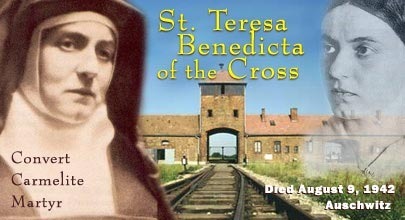
August 9th is the Feast Day of St. Teresa Benedicta of the Cross, who was martyred on that day in 1942 in the Auschwitz concentration camp.
Fr. Charles P. Connor, in Classic Catholic Converts, writes:
The story of the Jewish Carmelite Sister Teresa Benedicta of the Cross, known in the world as Edith Stein, presents us with one of the more brilliant converts to come to the Faith in [the twentieth] century; it also places us in close contact with a horrendous tragedy of the modern world, the Holocaust.
Edith Stein was born in Breslau, Germany on October 12, 1891, the youngest of eleven children. In 1913 she began studies at the University of Göttingen in Germany. She soon became a student of the phenomenologist Edmund Husserl and was later attracted to the work of Max Scheler, a Jewish philosopher who converted to Catholicism in 1920. A chance reading of the autobiography of Saint Teresa of Avila revealed to her the God of love she had long denied. She entered the Church in 1922.
For eight years Edith lived with the Dominicans, teaching at Saint Magdelene's, which was a training institute for teachers. She wrote:
Initially, when I was baptized on New Year's Day, 1922, I thought of it as a preparation in the Order. But a few months later, when I saw my mother for the first time after the baptism, I realized that she couldn't handle another blow for the present. Not that it would have killed her—but I couldn't have held myself responsible for the embitterment it would have caused.
In fact, after her conversion Edith continued to attend synagogue with her mother. Meanwhile, she continued to grow and impress as a philospher. In 1925 she met the Jesuit Erich Pryzwara, a philosopher who would have a tremendous influence on Hans Urs von Balthasar. Pryzwara encouraged Edith to study and translate St. Thomas Aquinas; she eventually wrote a work comparing Usserl with Aquinas.
In 1933 Edith entered the religious life with the Carmel of Cologne, Germany. She fell in love with the person and writing of Saint Thérèse of Lisieux. She wrote:
My impression was, that this was a life which had been absolutely transformed by the love of God, down to the last detail. I simply can't imagine anything greater. I would like to see this attitude incorporated as much as possible into my own life and the lives of those who are dear to me.
After taking her first vows, Edith was known as Sister Teresa Benedicta of the Cross. She continued to write, Fr. Connor notes, "continually developing the theme that Christ's sacrifice on the Cross and the Holy Sacrifice of the Mass are in fact one and the same sacrifice. From her religious background, she knew the importance of sacrificial prayer for Old Testament prophets." She wrote of how Jesus' sacrifice as the Incarnate God-man was the final, perfect sacrifice that replaced all of the sacrifices of the Old Testament.
Because of the rise of Nazi power, Edith and her sister Rosa, who had also converted to Catholicism, moved to Holland in 1938. On August 2, 1942, Edith and her sister were taken from the convent by two S.S. officers. She was martyred seven days later. Fr. Connor writes: "On October 11, 1998, fifty-six years, two months, and two days after her death at Auschwitz, Edith Stein, Sister Teresa Benedicta of the Cross, was canonized a saint of the Roman Catholic Church by Pope John Paul II."
Ferdinand Holböck writes in New Saints and Blesseds of the Catholic Church : 1984-1987 (Volume 2):
The Church now presents Sister Teresa Benedicta a Croce to us as a blessed martyr, as an example of a heroic follower of Christ, for us to honour and to emulate. Let us open ourselves up for her message to us as a woman of the spirit and of the mind, who saw in the science of the cross the acme of all wisdom, as a great daughter of the Jewish people, and as a believing Christian in the midst of millions of innocent fellow men made martyrs. She saw the inexorable approach of the cross. She did not flee in fear. Instead, she embraced it in Christian hope with final love and sacrifice and in the mystery of Easter even welcomed it with the salutation,"ave crux spes unica". As Cardinal Höffner said in his recent pastoral letter, "Edith Stein is a gift, an invocation and a promise for our time. May she be an intercessor with God for us and for our people and for all people."
Also see:
• Auschwitz and Catholic Jews | Dr. Ralph McInerny | Foreword to Edith Stein and Companions, On the Way to Auschwitz, by Father Paul Hamans
• The Cross and The Holocaust | Regis Martin
• Chapter 1 of Priestblock 25487: A Memoir of Dachau | Fr. Jean Bernard
• The Jews and the Second Coming | Roy H. Schoeman
• Judaism Fulfilled | An interview with Roy H. Schoeman
• Jews Find the Sweetness of Christ | Roy Schoeman
Rendered Imperfectly: A Review-Commentary of Jason Berry's "Render Unto Rome"

Rendered Imperfectly: A Review-Commentary of Jason Berry's Render Unto Rome | Reverend Brian Van Hove, S.J. | August 8, 2011 | Ignatius Insight
Render Unto Rome: The Secret Life of Money in the Catholic Church by Jason Berry
New York: Crown Publishers, 2011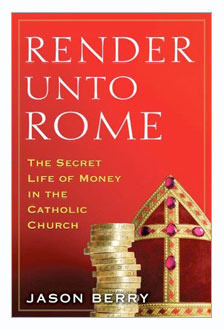
Pp. 420, including Notes and Index
ISBN-978-0-385-53132-0; eISBN- 978-0-385-53133-7
Like the Curate's Egg, this book is good in parts. When Jason Berry is good, he is very good. And when he is bad, he is quite bad. One presumes the author's lawyers approved both good and bad. First, let us consider selections from the bad.
Berry identifies himself with the "nursing-home-flower-children" of the church with over-worn expressions such as "pray, pay and obey." (pages 9, 279, and elsewhere) One senses he would blithely repeat all the liberal follies of the Episcopal Church (PECUSA) which once made it the fastest dying religious institution in America. [1] He is definitely not an advocate of the hermeneutic of continuity, but rather that of rupture. Let Berry spare us the rhetoric of the Sixties generation, revived recently by The American Church Council. Let a younger John Paul II Generation blossom.
Render Unto Rome is the final installment of what he terms an investigative trilogy begun in 1985. (page 17) We will wait for the decision of history to prune its merits. For now, here are highlights.
Who are the heroes and who are the villains in this book? Generally, the heroes are liberal nuns, select lay people and ex-priests. [2] We are given homey vignettes of their personal lives. Who are the villains? In general, corrupt and incompetent cardinals and bishops and their clerical cohorts. This must be said at the outset. Berry wants "reform from below" in a naīve way. There is no guarantee that liberal nuns (whose assets are secret), lay people and ex-priests would do a better job in a Fallen World than Cardinal Angelo Sodano or Cardinal Franc Rodé, to name but two of those he presents as his villains. [3] The Berry model of reform is unoriginal, as unoriginal as Congregationalism or Presbyterianism, and in a book that is designed to illuminate its readers with respect to "money," such vignettes (however interesting to certain religious subcultures) seem entirely gratuitous.
August 8, 2011
Um, I think you've forgotten a little detail...
... commonly referred to as "The Catholic Church":
It is easy to see why most people are contemptuous of this amalgam of credulity, sentimentality and narcissism, which in its evangelical Christian form is tied up with myths about the age of the earth and origin of species, sexual taboos and a conservative political agenda. With this as the public face of religion it's not surprising that in the US, as in Europe, Christianity is collapsing.
That is a shame because if it collapses everything essential to it and worthwhile, which is now merely obscure, will become inaccessible. Christian theology, metaphysical doctrines about the existence and nature of God that I believe to be true, will become curiosities, like the teachings of second-string neo-Platonists. Service books will languish in archives, for study by antiquarians. The better churches will be preserved as museums; mediocre ones will be gutted and refurbished as restaurants, condos and office space.
In Europe religious belief is already anomalous: San Vitale is a museum. In the US, Christianity has been absorbed into a syncretic mishmash of self-help programmes and therapies, new age products and scraps of eastern religions. There are cults for every taste and circumstance. Maybe some coherent religious system will surface in the way that Christianity emerged from the soup of cults and mystery religions in the Hellenistic world. Maybe Christianity will re-emerge. Maybe.
That from the conclusion to a short but rather heavy-handed, wild-eyed piece, "Christianity in the US is Collapsing", in today's edition of The Guardian. It sounds far more like a bitter wish than a thoughtful analysis of what and what might be.
Granted, there's no doubt that cases can be made for the poor health of Christian faith in the U.S., but, then, cases require facts, arguments, historical context, and so forth. Not weird and more-than-dubious statements such as this about the relationship between ancient Christianity and the Middle Ages: "Exuberance and wonder gave way to a crabbed obsession with sin and Christians turned inward to fret about the health of their souls." Right. Because, after all, when you read—to pick just one well-known example—Augustine's Confessions, you find nothing at all about sin and salvation and the state of one's soul. (Granted, I've only read the book four times, but I'm fairly certain Augustine mentioned sin and salvation in there somewhere.) Never mind that some guy named Paul of Tarsus, writing a wee bit earlier than Augustine, exhorted the Christians in Philippi to "work out your own salvation with fear and trembling" (Phil. 2:12), and that another man, Simon Peter, known to have lived and travelled with Jesus Christ for a few years, told his readers, "As the outcome of your faith you obtain the salvation of your souls" (1 Pet. 1:9). And so forth.
But Bible verses aren't really the issue here so much as the author's obvious contempt for evangelical Christianity; after all, she indicates no interest at all in Catholicism or Eastern Orthodoxy (nor can I see any such interest in her other columns). Even though Catholics are minorities among Christians in the U.S., they have a bit more history behind them in the larger, global picture; put another way, the Catholic Church has been declared down and out, dead in the water, and ten feet under many times throughout the past two thousand years (as Chesterton wrote about so well in The Everlasting Man). And while things are hardly perfect in the Catholic Church in the U.S. (and no serious Catholic thinks any such nonsense), they are, I think, notably better than in 1975 or 1989 or even 2003. And, to take it a step further and with an obvious nod to Louis Bouyer, Evangelicalism moves in one of two possible directions: toward the Catholic Church, or away from her. Evangelical groups that move away, especially by ditching essential Christian doctrines and beliefs about morality, surely do collapse and begin to die. Thus, forms of Protestantism in the U.S. that move further away from Catholicism will indeed keep collapsing. Mark Brumley, in writing about Bouyer's book, The Spirit and Forms of Protestantism, summed it up this way:
As we have seen, Bouyer argues for the Reformation's "positive principles" and against its "negative principles." But how did what was right from one point of view in the Reformation go so wrong from another point of view? Bouyer argues that the under the influence of decadent scholasticism, mainly Nominalism, the Reformers unnecessarily inserted the negative elements into their ideas along with the positive principles. "Brought up on these lines of thought, identified with them so closely they could not see beyond them," he writes, "the Reformers could only systematize their very valuable insights in a vitiated framework."
The irony is profound. The Reformation sought to recover "genuine Christianity" by hacking through what it regarded as the vast overgrowth of medieval theology. Yet to do so, the Reformers wielded swords forged in the fires of the worst of medieval theology–the decadent scholasticism of Nominalism.
The negative principles of the Reformation necessarily led the Catholic Church to reject the movement–though not, in fact, its fundamental positive principles, which were essentially Catholic. Eventually, argues Bouyer, through a complex historical process, these negative elements ate away at the positive principles as well. The result was liberal Protestantism, which wound up affirming the very things Protestantism set out to deny (man's ability to save himself) and denying things Protestantism began by affirming (sola gratia).
Bouyer contends that the only way to safeguard the positive principles of the Reformation is through the Catholic Church. For only in the Catholic Church are the positive principles the Reformation affirmed found without the negative elements the Reformers mistakenly affixed to them. But how to bring this about?
Bouyer says that both Protestants and Catholics have responsibilities here. Protestants must investigate their roots and consider whether the negative elements of the Reformation, such as extrinsic justification and the rejection of a definitive Church teaching authority and Tradition, are necessary to uphold the positive principles of sola gratia and the supremacy of Scripture. If not, then how is continued separation from the Catholic Church justified? Furthermore, if, as Bouyer contends, the negative elements of the Reformation were drawn from a decadent theology and philosophy of the Middle Ages and not Christian antiquity, then it is the Catholic Church that has upheld the true faith and has maintained a balance regarding the positive principles of the Reformation that Protestantism lacks. In this way, the Catholic Church is needed for Protestantism to live up to its own positive principles.
Read his entire essay, "Why Catholicism Makes Protestantism Tick". The sad irony, when one pulls back a bit and looks at the larger picture, is that the author of the Guardian column claims to be writing the obituary of one form of Protestantism while she herself is sitting among the tombstones of liberal Protestantism (specifically, the one marked "Episcopalian").
Carl E. Olson's Blog
- Carl E. Olson's profile
- 20 followers




